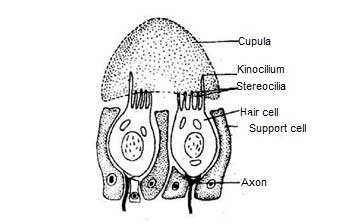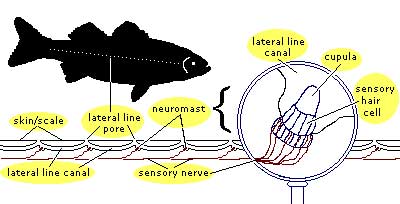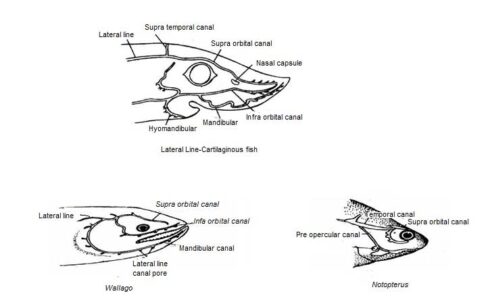A specialized organ or structure, such as the eye, ear, tongue, nose, or skin, in which a large number of sensory neurons are concentrated and which acts as a receptor component, is called a sensory organ. It is also called the recipient organ. Sensory organs receive physical or chemical stimuli from the environment. The dermal receptive organ is able to receive the physical changes of heat flow and the sensation of touch. Visual stimuli, such as changes in light and its properties, are transmitted through the eye and auditory sensations through the inner ear or lateral line organs. Experiments have shown that chemical stimuli are absorbed through the sense of smell. Fish have different types of sensory organs such as lateral line system, olfactory system, eye, ampullae of Lorenzini , membranous labyrinth and specialized organs like electric organs, Weberian ossicles etc. Most fish have a faint line along the sides of their trunk that extends from the head to the tail. Below this blurred line exists a canal, called the lateral line sensory organ.
It extends along both sides of the body. The canals extend longitudinally along the epidermis and are exposed outside the body through tiny pores on the skin at regular intervals. Lateral organs are found in cyclostomes, aquatic amphibians, and their larvae, in addition to fish. However, they were also found in the fossil ostracoderm. It consists of a number of trenches and holes arranged in rows. The canals come out through many holes. Rows of scales above the lateral line organ are perforated. Multiple lines can be seen on either side of the head. Some fish such as Cynoglossuss, Mugil, etc. have multiple lateral organs.
Structure of Lateral Line Sense Organ
In fish, it is a specialized and exceptional system. It is an integral part of the acoustico-lateralis system associated with the ear. This system has sensory lines which extend to the head and body. It consists of lateral line canals and neuromast organs.

Image Showing Lateral Line System
Lateral Line Canal
Neuromast cells are usually immersed in the cavity under the skin. The cells close at the top and form lateral line ducts. The lateral line duct exists as a continuous shaft that extends from the head in a specific pattern to the tail fin along both sides of the body. In this cavity, the neuromast or sensory receptors are lined up and densely located along the nerves, and the ducts are filled with numerous mucus cells.
In holocephali and in many primitive amphibians, the grooves are also open and the grooves of other fish are closed. In Lungfish (Protopterus) the roof of this duct is partially covered by a denticular covering. The closed ducts in the cranial region are exposed through tiny pores on the surface of the skin. In the embryonic and larval stages, a dorsal longitudinal, ventral longitudinal canal and a lateral longitudinal canal extend to each side of the body.
As it expands, the dorsal and ventral canals of the torso region disappear. However, the head region exists. In mature fish, the supra-orbital duct is above the eye, an infra-orbital duct is under the eye, a supra-temporal duct protrudes towards the back of the head and connects the lateral canal on each side. The mandibular, hyomandibular, and opercular canals meet each other.
Neuromast Organ
Neuromast organ is the receiving material of the lateral line organ system. In the outer layer of the epidermis the neuromast organ is located between the epithelial cells. These are immersed in the surface of the skin or groove in the lateral line canal. They mainly originate from the linear rows of embryonic ectodermal placodes of the head, body, and tail. Neuromast organs are made up of two types of cells, namely: (1) Sensory receptor or hair cell and (2) supporting cell.
The receptor cells are pear-shaped. They form clusters in the center of the neuromast organ and are surrounded by many helper cells. The helper cells are long and slender and are arranged around the sensory or receptor cells to form the circumference of the neuromast organ. Every sensory cell has a hair-like growth. Each follicle contains 20-25 small stereocilia and a large kinocilium at one end. A gelatin-like substance called cupula is secreted by neuromast cells and thrown into the water. The remaining cells are polarized towards the kinocilium. Due to the movement of water, any displacement of the cupuler is transported to hair-like growth. The base of receptor hair cells extends to the axonic fibers of the 8th, 9th, and 10th cranial nerves. Neuromast organs transform into ampullae of Lorenzini in some fish.

Image Showing Neuromast Organ
Sharks have two lateral canals along their entire body length. The canals on both sides of the body in the head region are connected to the apex by a transverse supra-temporal canal. There are different types of cephalic canals such as a supra-orbital, an infra-orbital and a mandibular canals. The supra-orbital protrudes along the surface of the eye and joins the infra-orbital canal from the back of the nasal capsule to the anterior. The sub-mandibular canal is subsequently generated from the infra-orbital canal. It extends into the hyoid arch and progresses under the eyes and reaches to the tip of the snout. The mandibular branch extends to the tip of the lower jaw and joins the similar canals on the other side.
Some variations in the pattern of the lateral line canals and the arrangement of the neuromast organs are observed in bony fish. The canals are located in the epidermis as a canal and the small canals are exposed outside the skin through the pores. The supra-orbital canal of the head region is connected to the temporal canal of the lateral line canal. The infra-orbital canal is similarly advanced. The canal of the hyoid arch is connected to the temporal and mandibular canals. Its presence can be noticed by the groove-like line on the cheek of the fish.

Image Showing Lateral Line Canal in Fishes
In polypterus (Chondrostei), the supra-orbital is attached to the infra-orbital at the tip of the trunk. Its wide variation can be noticed in teleost. Normally all cephalic canals such as supra-orbital, infra-orbital and hypomandibular are connected to the lateral line canals of the body. A supra-temporal or occipital canal is transversely connected to the lateral line canal near the head. The supra-orbital may or may not be attached to the temporal canal and may not be attached to the infra-orbital at the anterior end of the snout. In Heteropneustes fossilis and Wallago attu they are attached behind the eyes. However, in Cyprinids it is different.
The hyoid arch canal is connected to the temporal canal. But in most cases it ends in a line. The mandibular canal in Cyprinids is weak and in Silurids it is clearly developed. The lateral line canal of Chitala chitala does not connect the cephalic canal.
Abyssal species such as Gulper eel and Ceratoid anglers do not have lateral line canals. However, the papillae of the skin act as sensory organs. Fish of the family Macrouidae have numerous lateral lines. In Cobitids they are widespread throughout the face region.
Nerve Supply
The branch travels from the seventh (facial) cranial nerve to the neuromast organ in the head region. The ninth (glossopharyngeal) cranial nerve reaches the supratemporal canal. The lateral branch of the tenth (vagus) cranial nerve goes to the lateral canal of the body. Different types of fish have slight differences in the structure of the lateral organs. In Rhodeus the body is reduced to the maximum degree. The mugil has many parallel lateral line organs.

Lateral Lines of Different Fishes
Functions of Lateral Line Organ
According to Hoagland, the functions of lateral line organ are as follows:
- This organ may receive sound in order to resemble the sensory cells of the inner ear and the lateral organ;
- It can perceive temperature changes
- It can perceive the different water pressure;
- If any mechanical vibration in the aquatic environment creates an abnormal environment, this organ can inform the fish;
- Through this organ, the fish may be able to locate a distant object and take the necessary action;
- The fish can detect its prey and predators in the water by taking the sound frequency;
- Through this organ, the schooling ability of the fish is acquired so that every fish in a school interacts with each other.
